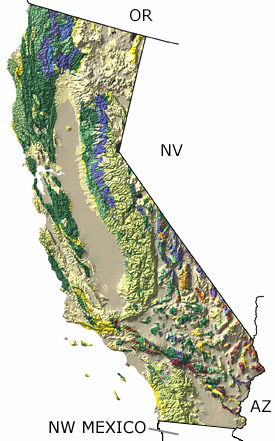Paleontology and geologyThe Precambrian and Paleozoic: Sedimentary rocks from the Precambrian and Early Paleozoic are most often found in the White Mountains, Inyo Mountains, and near Death Valley in Southern California. The Precambrian rocks rarely contain fossils, but deposits from the Cambrian through Devonian contain numerous fossils, such as corals, ammonites, and brachiopods, indicating a shallow, warm water environment teeming with life. The fossil record of the later Paleozoic (Carboniferous and Permian), best represented in Northern California (Shasta and Butte Counties), indicates both shallow and deep water deposits, as well as swamps and estuarine environments. Some of the late Paleozoic rocks are most likely exotic terranes that were carried in from the west as a result of tectonic activity.
The Mesozoic: The Mesozoic was a time of extensive tectonic activity and volcanism associated with the rise of the Sierra Nevada. As these mountains eroded, their deposits accumulated in the Central Valley forming the rocks of the Great Valley Sequence. Mesozoic rocks and fossils from marine and terrestrial environments are broadly distributed throughout the state. This fossil record includes a high diversity of invertebrates, as well as marine reptiles, ginkgoes, cycads, and conifers.
The Cenozoic: During the Tertiary, tectonic and volcanic activity that began in the Cretaceous continued to uplift the Coast and Transverse Ranges. Shallow marine, estuarine, freshwater, and terrestrial rocks were deposited around the state as sea levels fluctuated. Glaciers, lakes, and large river systems developed during the Quaternary. Well-preserved fossils from their deposits reveal a flora and fauna not too different from that of today. Deposits like the La Brea Tar Pits remind us that numerous large vertebrates, such as the saber-tooth cats, camels, and mammoths, also roamed the state. |

